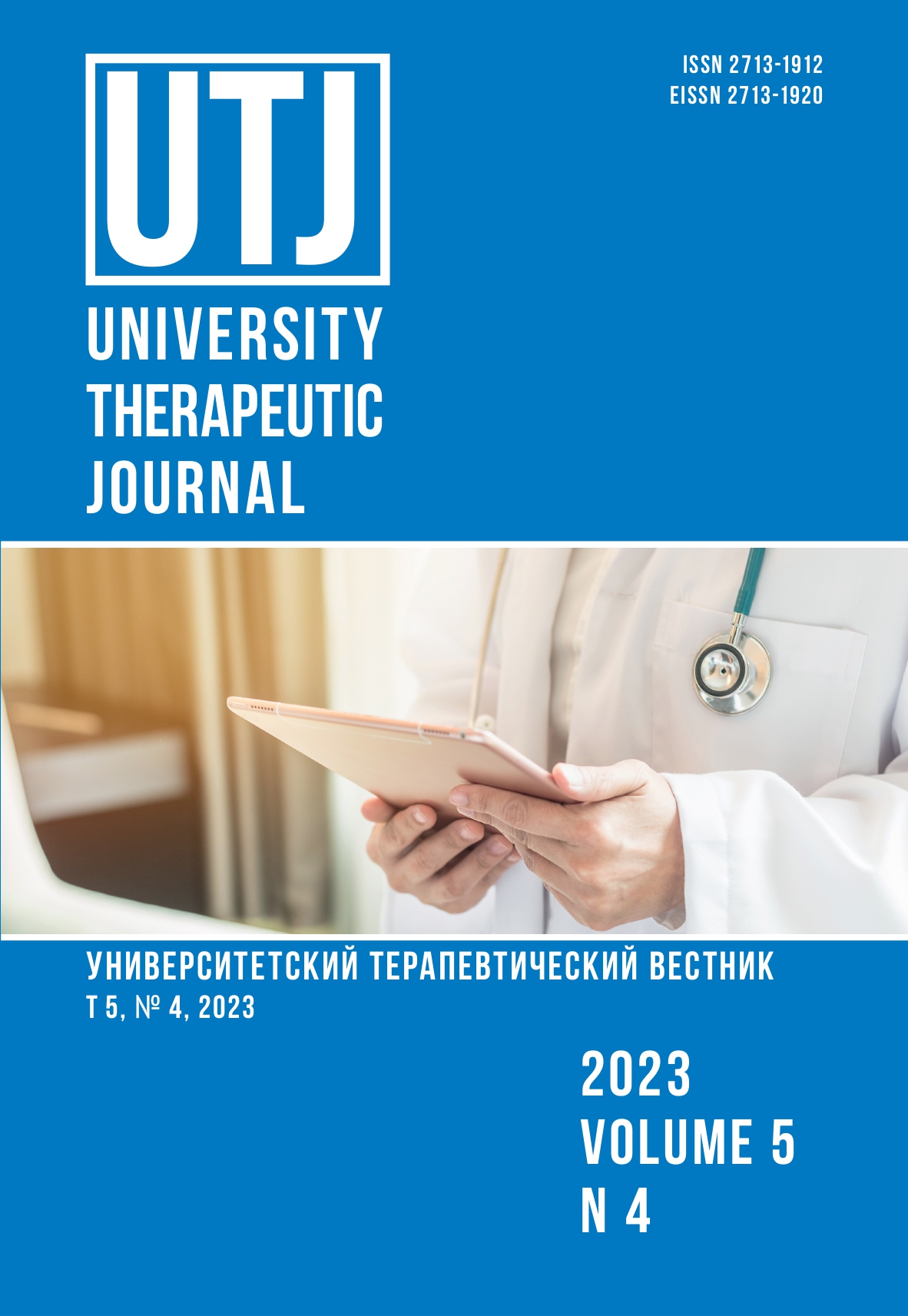MORPHOLOGICAL FEATURES OF CHRONIC GASTRODUODENITIS IN PATIENTS AFTER CHOLECYSTECTOMY: RESULTS OF THE ORIGINAL STUDY
Abstract
Introduction. Biliary gastritis is becoming widespread in clinical practice. Etiopathogenetic links, the effect of H. pylori on the course of the disease has not been fully studied. Objective: to analyze the expression of immunohistochemical markers in the gastric mucosa and duodenum depending on the presence of biliary gastritis and/or H. pylori-associated gastritis before and 6 months after cholecystectomy for gallstone disease. Materials and methods. The obtained biopsy material of the gastric mucosa and duodenum was studied in 64 patients who applied to St. Petersburg State Medical Institution “Elizabethan Hospital” with indications for HE for GI. The average age was 46.3 ± 9.7 years. Immunohistochemical method reveals expression of CD95, Ki-67, CDX2, CD34, VEGF markers in biopsies. Results. Patients were divided into 3 groups. In group I (non-biliary and HP non-associated gastritis) there were no pronounced changes in the mucous membrane of the stomach and duodenum. In group II (biliary and HP-associated gastritis), an increase in proliferation markers (Ki-67, CDX2), apoptosis marker (CD95) was found after 6 months, mainly in the body and antrum of the stomach. The greatest accumulation of CD34 and VEGF markers in the stomach was also noted, mainly in the own plate of the gastric mucosa. In group III (biliary and HP non-associated gastritis) the content of markers Ki-67, CDX2 was higher compared to biopsies before HE. Immunohistochemical study of endothelial factors (CD34 and VEGF) demonstrated an increase in their expression mainly in the cardiac and antrum of the stomach. Conclusion. Groups II and III had a higher assessment of markers of proliferative activity and vascular markers 6 months after cholecystectomy for gallstone disease, which probably contributes to gastric carcinogenesis associated with the influence of pathological duodenogastric reflux and H. pylori.
References
Гурова М.М., Куприенко В.В. Особенности лабораторной и инструментальной оценки состояния верхних отделов пищеварительной системы у детей с хроническим гастродуоденитом, ассоциированным с хеликобактерной инфекцией. Медицина: теория и практика. 2019; 4(3): 183–9.
Насыров Р.А., Фоминых Ю.А., Кизимова О.А., Белевитин А.Б. Дуоденогастральный рефлюкс и желчнокаменная болезнь: патогенетические и клинико-морфологические взаимосвязи. University Therapeutic Journal. 2023; 5(1): 36–52. DOI: 10.56871/UTJ.2023.51.60.002.
Ивашкин В.Т., Маев И.В., Трухманов А.С. и др. Рекомендации Российской гастроэнтерологической ассоциации по диагностике и лечению гастроэзофагеальной рефлюксной болезни. Российский журнал гастроэнтерологии, гепатологии, колопроктологии. 2020; 30(4): 70–97. DOI: 10.22416/1382-4376-2020-30-4-70-97.
Новикова В.П., Листопадова А.П., Замятина Ю.Е. и др. Влияние энтеросорбции на цитокиновый статус при гастродуодените и сопутствующих атопических заболеваниях у детей. Медицина: теория и практика. 2019; 4(1): 195–204.
Atak I., Ozdil K., Yücel M. et al. The effect of laparoscopic cholecystectomy on the development of alkaline reflux gastritis and intestinal metaplasia. Hepatogastroenterology. 2012; 59(113): 59–61. DOI: 10.5754/hge11244. PMID: 22260822.
He Q., Liu L., Wei J. et al. Roles and action mechanisms of bile acid-induced gastric intestinal metaplasia: a review. Cell Death Discov. 2022; 8(1): 158. DOI: 10.1038/s41420-022-00962-1. PMID: 35379788; PMCID: PMC8979943.
Li D., Zhang J., Yao W.Z. et al. The relationship between gastric cancer, its precancerous lesions and bile reflux: A retrospective study. J Dig Dis. 2020; 21(4): 222–9. DOI: 10.1111/1751-2980.12858. Epub 2020 Apr 21. PMID: 32187838; PMCID: PMC7317534.
Mercan E., Duman U., Tihan D. et al. Cholecystectomy and duodenogastric reflux: interacting effects over the gastric mucosa. Springerplus. 2016; 5(1): 1970. DOI: 10.1186/s40064-016-3641-z. PMID: 27917345; PMCID: PMC5108731.
Othman A.A., Dwedar A.A., ElSadek H.M. et al. Post-cholecystectomy bile reflux gastritis: Prevalence, risk factors, and clinical characteristics. Chronic Illn. 2022: 17423953221097440. DOI: 10.1177/17423953221097440. Epub ahead of print. PMID: 35469484.
Shi X., Chen Z., Yang Y., Yan S. Bile Reflux Gastritis: Insights into Pathogenesis, Relevant Factors, Carcinomatous Risk, Diagnosis, and Management. Gastroenterol Res Pract. 2022; 2022: 2642551. DOI: 10.1155/2022/2642551. PMID: 36134174; PMCID: PMC9484982.
Takahashi Y., Uno K., Iijima K. et al. Acidic bile salts induces mucosal barrier dysfunction through let-7a reduction during gastric carcinogenesis after Helicobacter pylori eradication. Oncotarget. 2018; 9(26): 18069–83. DOI: 10.18632/oncotarget.24725. PMID: 29719591; PMCID: PMC5915058.
Tatsugami M., Ito M., Tanaka S. et al. Bile acid promotes intestinal metaplasia and gastric carcinogenesis. Cancer Epidemiol Biomarkers Prev. 2012; 21(11): 2101–7. DOI: 10.1158/1055-9965. EPI-12-0730. Epub 2012 Sep 25. PMID: 23010643.
Zhao A., Wang S., Chen W. et al. Increased levels of conjugated bile acids are associated with human bile reflux gastritis. Sci Rep. 2020; 10(1): 11601. DOI: 10.1038/s41598-020-68393-5. PMID: 32665615;
PMCID: PMC7360626.


